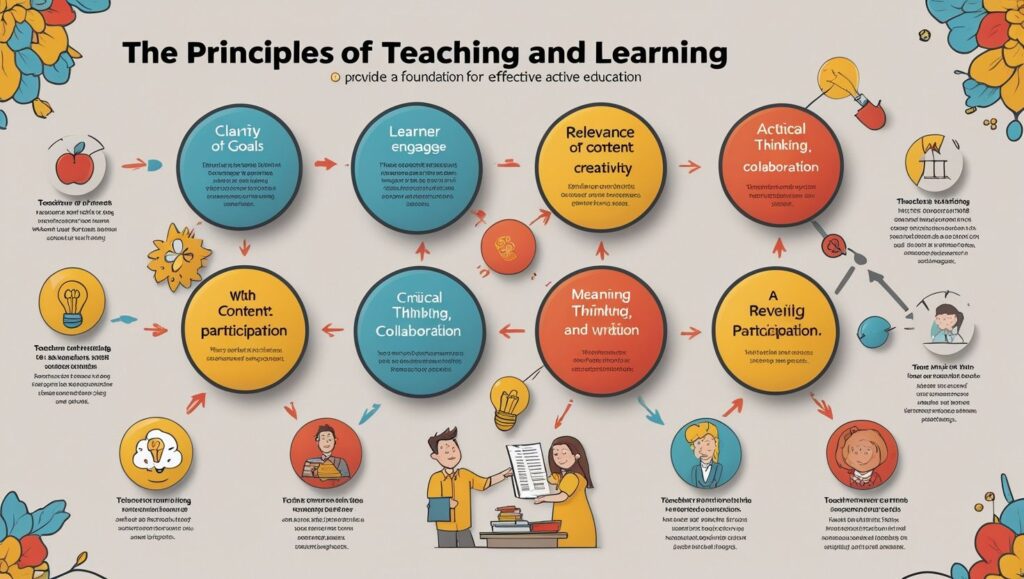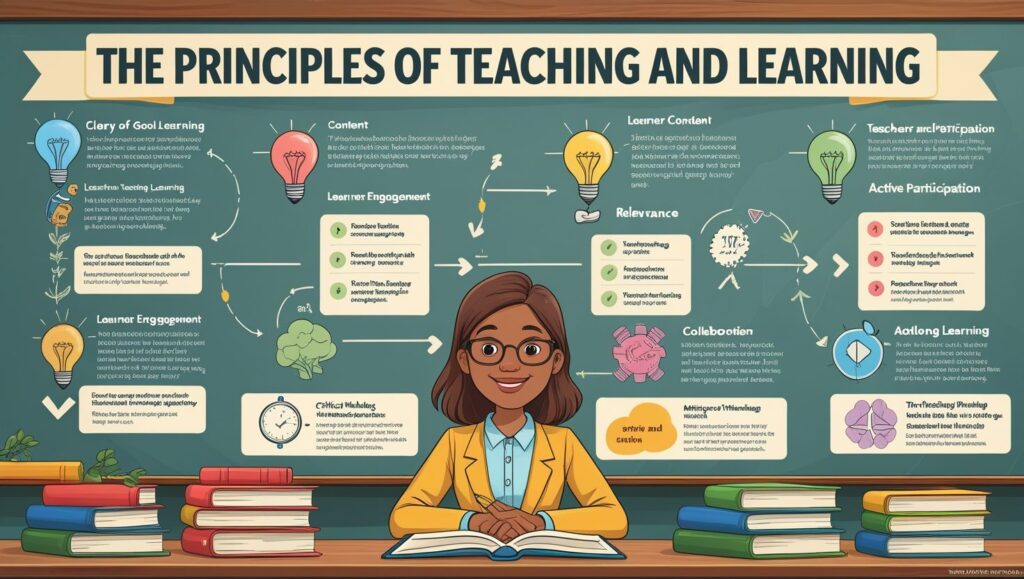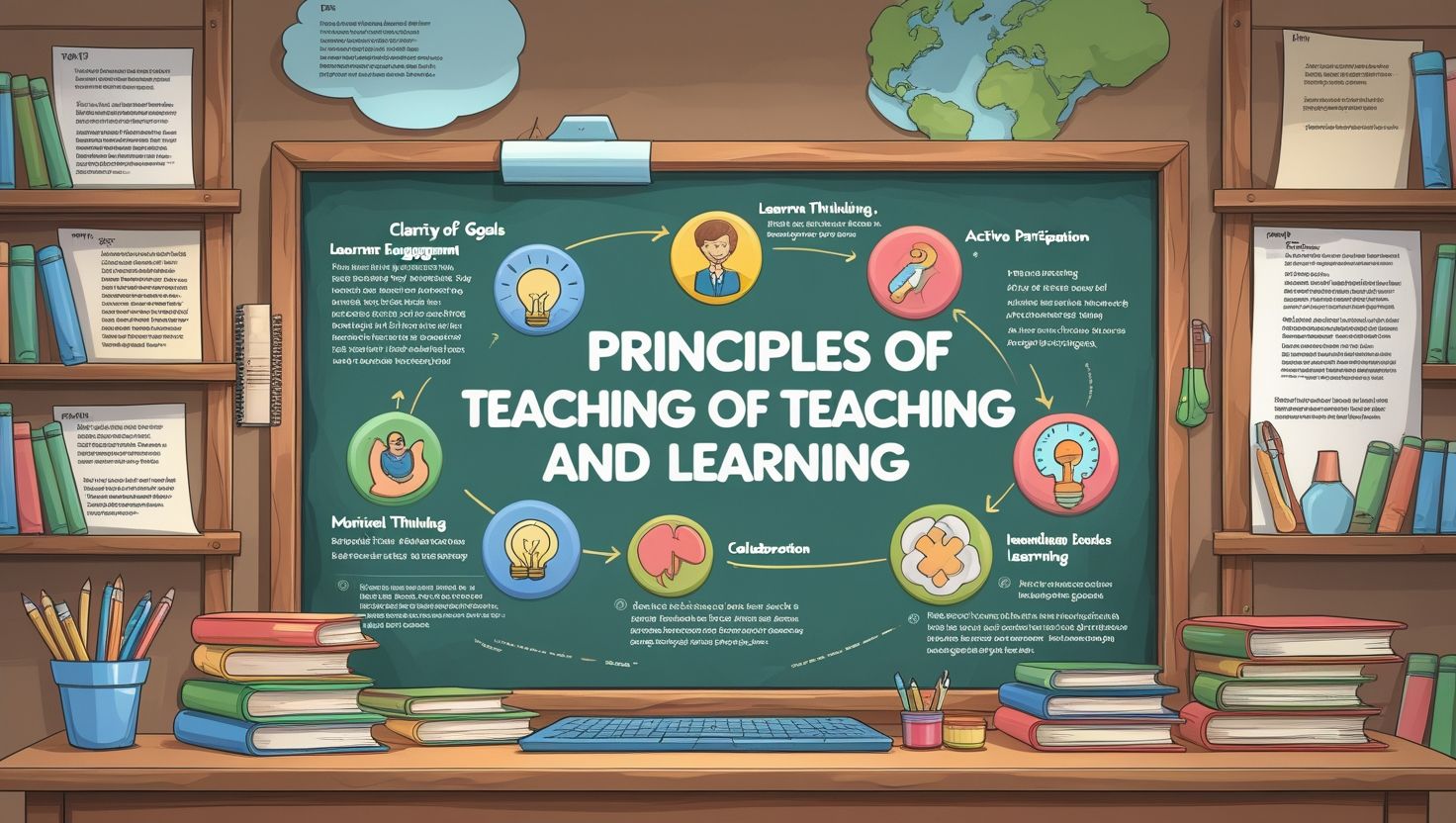Introduction
Principles of Teaching and Learning, The principles of teaching and learning form the foundation of effective education. These principles guide teachers in delivering knowledge and students in acquiring it meaningfully. Teaching is not only about transferring information but also about inspiring curiosity, critical thinking, and problem-solving. Learning, on the other hand, is about building understanding, skills, and values that shape personal and professional life. Moreover, when these principles are applied, classrooms become dynamic, interactive, and productive. Teachers can adapt their strategies to meet the diverse needs of learners. At the same time, students become active participants rather than passive receivers of knowledge. Furthermore, these principles ensure that teaching is purposeful and learning is lasting. By following universal guidelines, educators enhance engagement, motivation, and retention. Thus, exploring these principles helps us understand how education becomes effective, transformative, and relevant in preparing individuals for future challenges.
Principle of Clarity of Objectives
The principle of clarity of objectives is essential in both teaching and learning. Every lesson must begin with clear goals so that both teacher and students understand the purpose. When learners know what is expected, they become more focused and motivated. Objectives serve as a roadmap, guiding teaching methods and learning activities. Moreover, specific and measurable goals help in assessing progress effectively. Teachers who communicate objectives clearly can align content, resources, and evaluation with desired outcomes. Additionally, clarity reduces confusion and ensures that teaching remains systematic. Students also benefit by being able to track their own progress. Furthermore, clear objectives encourage accountability in both teachers and learners. This principle also ensures that lessons are meaningful and connected to real-life applications. Without defined objectives, learning becomes random and ineffective. Thus, the clarity of objectives creates direction, purpose, and structure in the entire process of teaching and learning.
Principle of Motivation
The principle of motivation highlights the role of interest and encouragement in learning. Students learn best when they are inspired and engaged. Teachers must create enthusiasm by using relevant examples, interactive activities, and real-life applications. Motivation can be intrinsic, driven by personal curiosity, or extrinsic, encouraged by rewards and recognition. Moreover, positive reinforcement boosts confidence and helps learners overcome challenges. A motivated student is more likely to participate actively and retain knowledge. Teachers must also understand the needs, desires, and goals of their learners to sustain interest. Furthermore, motivation is not only about academic rewards but also about emotional encouragement and appreciation. By making learning enjoyable, teachers ensure students remain consistent in their efforts. Additionally, motivated learners develop problem-solving skills and perseverance. Consequently, the principle of motivation creates energy, focus, and determination in classrooms, making the learning experience engaging, effective, and long-lasting for every learner.

Principle of Activity and Participation
The principle of activity and participation emphasizes that learning becomes more effective when students are actively engaged. Passive listening alone does not guarantee understanding. Therefore, teachers must involve learners in discussions, experiments, group work, and problem-solving exercises. Active participation allows students to apply knowledge in practical ways. Moreover, participation develops critical thinking, communication, and teamwork skills. Through interactive activities, learners gain confidence and retain concepts for longer periods. Additionally, active engagement makes classrooms lively and enjoyable. Teachers should also provide opportunities for questioning, role-playing, and projects that connect theory with practice. Furthermore, when learners participate, they take ownership of their learning journey. This reduces dependency and encourages independence. By fostering participation, educators ensure that students are not only recipients of knowledge but also co-creators of it. Thus, the principle of activity and participation transforms classrooms into collaborative spaces where knowledge is explored, applied, and reinforced effectively.
Principle of Individual Differences
The principle of individual differences recognizes that every learner is unique. Students differ in abilities, interests, learning styles, and pace of understanding. Therefore, teachers must adopt flexible strategies that cater to this diversity. Some learners grasp concepts quickly, while others need more time and support. Moreover, cultural, social, and emotional factors also influence learning outcomes. Acknowledging these differences prevents neglect and ensures inclusivity in classrooms. Teachers can use differentiated instruction, varied teaching materials, and personalized feedback to address diverse needs. Additionally, cooperative learning allows students to support each other and bridge learning gaps. When teachers respect individuality, students feel valued and motivated. Furthermore, this principle fosters equality and fairness in education. Ignoring individual differences leads to frustration and underachievement. Consequently, the principle of individual differences is essential for creating supportive learning environments where every student has an equal opportunity to succeed and grow academically and personally.
Principle of Learning by Doing
The principle of learning by doing stresses that real understanding comes through practical experience. Students remember concepts better when they apply them in real situations. Classroom activities such as experiments, fieldwork, and projects provide opportunities for active exploration. Moreover, this principle connects theory with practice, making learning meaningful. Teachers must encourage hands-on experiences that stimulate creativity and problem-solving. Additionally, practical activities develop life skills such as decision-making, collaboration, and adaptability. Learning by doing also boosts confidence as students see the results of their efforts. Furthermore, this principle aligns with modern approaches like experiential and project-based learning. Passive memorization often fades quickly, but active involvement ensures long-term retention. Teachers can integrate simulations, role-playing, and case studies to make lessons engaging. Consequently, the principle of learning by doing ensures that students develop deeper understanding and practical competence, preparing them for challenges beyond the classroom environment.
Principle of Correlation with Life
The principle of correlation with life emphasizes that learning should be connected to real-life situations. Students understand and value education more when they see its relevance to daily life. Teachers must link academic concepts with practical experiences, making lessons meaningful. For example, mathematics can be connected to shopping, budgeting, or measurements. Similarly, science lessons can be related to health, environment, and technology. Moreover, correlating lessons with life encourages problem-solving and critical thinking. It also helps students develop social and moral values. Furthermore, knowledge becomes more applicable when learners relate it to their own experiences. Teachers should encourage discussions and examples from students’ everyday lives to strengthen this connection. Additionally, such learning motivates students to apply classroom knowledge in real-world challenges. Thus, the principle of correlation with life ensures that education is not limited to textbooks but becomes a practical guide for success and responsible living.

Principle of Reinforcement and Feedback
The principle of reinforcement and feedback is vital for strengthening learning outcomes. Positive reinforcement, such as praise, rewards, or recognition, motivates students to continue their efforts. Feedback, when constructive, helps learners identify strengths and areas of improvement. Moreover, reinforcement ensures that correct responses are repeated, while errors are gradually corrected. Teachers must provide timely feedback so that students can reflect and make adjustments. Additionally, reinforcement can be both intrinsic and extrinsic, depending on the situation. Effective feedback encourages students to set new goals and strive for excellence. Furthermore, reinforcement builds confidence and reduces fear of failure. It also maintains interest and sustains motivation throughout the learning process. Without reinforcement and feedback, students may lose direction and interest. Therefore, the principle of reinforcement and feedback ensures that learning is continuous, consistent, and rewarding, helping students achieve their maximum potential with confidence and clarity.
Principle of Readiness
The principle of readiness highlights the importance of mental, emotional, and physical preparedness in learning. Students learn best when they are ready to receive knowledge. If they are distracted, stressed, or uninterested, learning becomes ineffective. Therefore, teachers must create an environment that stimulates curiosity and interest. Readiness depends on age, maturity, background knowledge, and motivation. Moreover, teachers should design lessons according to the developmental stage of learners. When students are mentally prepared, they grasp concepts faster and retain them longer. Furthermore, readiness reduces frustration and increases confidence in learning. Teachers can encourage readiness by using engaging introductions, asking thought-provoking questions, and connecting lessons with student interests. Additionally, providing supportive classroom environments ensures emotional readiness. Consequently, the principle of readiness ensures that learning takes place smoothly and effectively, as students approach lessons with openness, enthusiasm, and a positive attitude toward gaining new knowledge.
Principle of Continuity and Recapitulation
The principle of continuity and recapitulation stresses that learning should be consistent and reinforced regularly. Knowledge is best retained when it is revisited and practiced over time. Teachers must ensure continuity by linking new lessons with previous knowledge. Moreover, recapitulation helps learners recall and strengthen what they have learned. Repetition through exercises, discussions, and summaries solidifies understanding. Furthermore, continuity ensures that education progresses step by step without leaving gaps. When students revise and connect past and present knowledge, learning becomes deeper and more meaningful. Teachers can use questioning, assignments, and group discussions for effective recapitulation. Additionally, this principle prepares students for advanced topics by building strong foundations. Without continuity, knowledge fades quickly, and learning becomes fragmented. Consequently, the principle of continuity and recapitulation ensures long-term retention, smooth progression, and strong integration of knowledge, making education a lifelong process rather than a temporary experience.
Conclusion
The principles of teaching and learning provide direction and effectiveness to the educational process. They ensure that lessons are purposeful, motivating, and inclusive. By applying principles such as clarity of objectives, motivation, activity, individual differences, and learning by doing, teachers make classrooms engaging and practical. Furthermore, correlation with life, reinforcement, readiness, and continuity ensure that knowledge is meaningful, retained, and applied in real situations. These principles emphasize that education is not only about knowledge transfer but also about holistic development. Moreover, they remind educators to respect learners’ individuality while fostering collaboration and participation. By practicing these universal guidelines, teachers enhance the quality of learning and prepare students for life beyond classrooms. Ultimately, the principles of teaching and learning transform education into a process of growth, discovery, and empowerment, ensuring that both teaching and learning remain purposeful, impactful, and sustainable in every context.

I am not sure where youre getting your info but good topic I needs to spend some time learning much more or understanding more Thanks for magnificent info I was looking for this information for my mission
Hey there would you mind sharing which blog platform you’re working with?
I’m planning to start my ownn blog in the near future
but I’m having a tough time choosing between BlogEngine/Wordpress/B2evolution and Drupal.
Thhe reason I ask is because your design and style seems
different then most blogs and I’m looking for something unique.
P.S My apologies for getting off-topicbut I had
to ask! https://U7Bm8.Mssg.me/
Excellent post. I used to be checking continuously this blog and I’m impressed!
Very useful information specifically the ultimate part 🙂 I
care for such info a lot. I was looking for this particular info for a very long time.
Thanks and good luck.